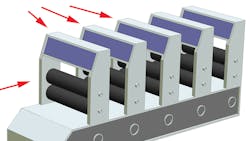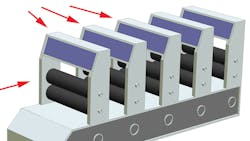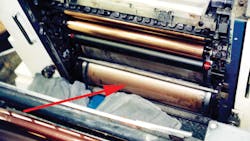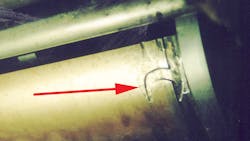Each roll and cylinder mounts in a structure called a stand, with several stands making up the machine. The stands are aligned, and their operation is synchronized to accept the printed product as it is processed through the machine.
A typical stand may support an impression cylinder, offset cylinder, plate cylinder, ink roller, and water roller. Maintenance personnel at the scene said they were trying to adjust the machine while it was running. During the adjustment process, the technician working on the machine dropped a wrench that was immediately ingested into the first cylinder and expelled through all the remaining cylinders.
Most of the cylinders were damaged with the imprint of the tool. All rolls and cylinders were out of sync, suggesting additional damage to drive systems. Also, stands affected by the wrench vibrated severely. The machine was relatively new with no deficiencies noted prior to failure, suggesting the damage to the machine resulted from the ingestion of the wrench.
Machine designers should take a lesson from this incident: It can be a good design practice to create adjusting systems which limit the propensity of foreign objects to be drawn into a machine. Perhaps the most obvious way of accomplishing this goal is to require that the machine be stopped before it can be adjusted. However, this may not be practical in machinery that must operate during adjustment so the technician can gauge vibration, velocity, and so forth. The inclusion of an adjusting knob, rather than forcing technicians to use a separate tool, could solve the problem. It may also help to pick an adjustment location some distance from the moving parts of the machine, but this approach could add complexity that may, in turn, make the whole machine less reliable.
Finally, an automatic adjustment system utilizing feedback from various sensors may be a more ideal answer. It would completely eliminate the need for manual adjustment.
Charles C. Roberts, Jr., Ph.D., P.E. is an engineering consultant in the areas of accident reconstruction, failure analysis, structural analysis, heat transfer, fire origin analysis, computer analysis, mechanics, and biomechanics. He can be reached at [email protected].
About the Author
Charles Roberts, Jr.
Charles C. Roberts, Jr., Ph.D., P.E. is an engineering consultant in the areas of accident reconstruction, failure analysis, structural analysis, heat transfer, fire origin analysis, computer analysis, mechanics, and biomechanics. He can be reached at [email protected].




